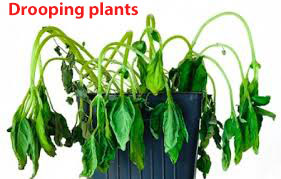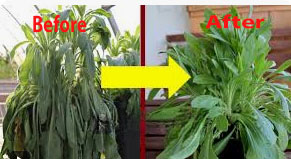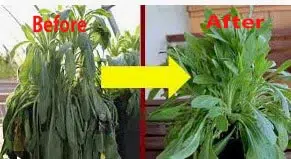Drooping plants is a big worry for both experienced and new gardeners. The problem causes wilting, sagging, or drooping of stems and leaves. This issue can indicate various dangerous issues in the drooping plants.
It is crucial to find out the main reason behind the drooping plants and ensure to treat it carefully. Various reasons and factors cause plant leaves drooping, as well as the stem of African violet drooping.
We will dive deep into the factors and reasons that are responsible for my plant looks droopy. The plant leaves drooping can be a cause of water shortage, small space, and root problems.
Common Causes of Plants Drooping
There can be different problems such as African violet limp leaves, aglaonema drooping, and my peace lily is drooping and these all are the result of some common factors. They may have nutrient deficiencies, poor soil, inadequate light, water stress, and environmental problems.
Each of these problems may affect the plant differently and may have unique and different symptoms. Bad watering practices such as underwatering or overwatering can affect the plants and can become the factor behind my plant looks droopy.
Overeating and underwatering practices are very common and frequent factors in gardening problems. This can cause problems in alliums drooping flowers and allium leaves drooping. Nutrient deficiencies also cause problems in plants and drooping plants are one of these problems.
The lack of magnesium, potassium, and nitrogen can cause plant leaves drooping, and drooping plants. It weakens the plants and eventually limp and fall. Inadequate light or partial shade is good for some plants which are compatible with partial shade conditions but most of the plants suffer due to inadequate light and partial shade.
Improper light can prevent the plants from growing, and photosynthesizing. This will lead to drooping plants and weaken plants.

Soil plays an important role in the good health of plants. If the soil is healthy and good the plants would be heapy and healthy. But if the soil is compacted, or not drained properly it will result in agapanthus flowers drooping, African violet flowers drooping, drooping plants, and plant leaves drooping.
The roots will suffocate and the plant will decline. Environmental stress can cause drooping plants. alocasia black velvet drooping, aglaonema stems drooping, aglaonema drooping, or allium leaves drooping can be the cause of environmental problems.
Extreme heat or cold, pests, strong winds, and bacterial issues can cause drooping plants and plant leaves drooping. Before you opt for the treatment of drooping plants or my plant looks droopy, you can examine the problem and act accordingly.
Choose the best option, that is not harmful to the environment and the biosystem.
For Detailed info about drooping plants:
Identifying Water Stress in Plants
Water stress is a little complex problem in drooping plants as overwatering and underwatering have the same features. Improper watering practices can lead to allium leaves drooping, alocasia amazonica drooping, alocasia black velvet drooping, and plant leaves drooping and stems.
To identify the problem properly, check the moisture level in the soil. Yellow leaves, wet soil, and root rot are some basic signs and symptoms of overwatered plants.
On the other hand, crumbly soil, brown leaves, brown edges, and dry soil are some points that can indicate underwatering practices. Adjust your watering practices accordingly to avoid plant leaves drooping and drooping plants.
The simplest method to check the watering balance in the garden is to stick your finger into the soil about an inch for a while to check the humidity levels of the soil. If it feels dry, clumsy, and crumbly increase your watering schedule.
If the soil feels wet or humid, reduce the watering level in the garden. Keep an eye on the watering balances of the garden to avoid underwatering or overwatering in the garden. You can avoid any type of stress or disease out of the garden by regular checks and maintenance.
Impact of Overwatering and Underwatering
Overwatering and underwatering are some of the main reasons for the problem of ‘my peace lily is drooping’ with distinctive symptoms. Overwatering will lead to root rot when the roots become waterlogged and start to decay or decline due to suffocation or lack of oxygen.
This will cause the prevention of nutrient absorption, and not let the plant get proper water which will lead to plant leaves drooping and drooping plants. The symptoms of this issue are mushy roots, an unpleasant smell from the plant roots and soil, and yellowing leaves.
While underwatering, on the other hand, underwatering may cause the lack of moisture in the soil that the plants need to carry out essential functions such as nutrient transport and photosynthesis.
The symptoms can include dry and brittle leaves, dry soil, drooping plants and plant leaves drooping and wilting. It is necessary to keep balance and check on the watering practices in your garden. Proper watering practices can help you avoid both the extremes of overwatering and underwatering.
Good watering practices will help you maintain a good and healthy gardening environment without the problems of agave leaves drooping, African violet drooping leaves, or other drooping plants.
Nutrient Deficiencies Leading to Drooping
Nutrients are essential for the health and growth of plants. Deficiency of nutrients can cause different problems in the plants. drooping plants or plant leaves drooping are one of the main results of nutrient deficiencies. Plants need nutrients such as potassium, phosphorus, and nitrogen.
The deficiency can result in stunted growth, yellow leaves, and drooping plants. African violet limp leaves, aglaonema leaves drooping, and alocasia amazonica leaves drooping are some of the main outcomes of nutrient deficiencies.

Phosphorus plays an important role in the development of roots, stems, and overall growth of the plants. The lack of it will cause weak root structures and weak stems eventually leading to drooping plants. Potassium regulates water in the plants and helps plants resist diseases.
The absence of it would cause weak plants and susceptible to wilting, drooping, and stress. alliums drooping flowers, alocasia black velvet drooping, and agapanthus flowers drooping are some of the main problems that may occur in the absence of these nutrients.
For potassium Read:
University of Minnesota:
https://extension.umn.edu/phosphorus-and-potassium/potassium-crop-production
To treat these problems effectively, you can use organic matter to deter the problems and diseases. Fertilize the plants properly and timely to avoid further spread of the issues. Do not use fertilizers that are harmful to the environment or biodiversity.
Use fertilizers according to the needs of the plants to balance the nutrients and ensure the health and growth of the plants.
The Role of Light in Plant Health
Light is one of the main factors for the growth of the plants. Good light is essential for plants to maintain good growth, health, and productivity. Insufficient light can cause different problems in the plants and drooping plants is one of them.
Plants can not perform their activities to process nutrients, water, or insufficient light into energy if the plants are not getting adequate light. They can not perform photosynthesis which will eventually lead to weak leaves and stems and finally drooping plants.
Adequate light is necessary for good plantation and gardening. Overlighting can cause wilt, droop, and scorch on the leaves which will lead to drooping plants. Insufficient light can cause elongated stems, sparse foliage, and leggy plants. This will make my plant look droopy.
Understand the specific requirements of your plants and garden. Ensure the plants receive adequate lighting whether it is indirect light, full sun, or partial shade. Proper and adequate light is necessary to promote healthy plantation and productive gardening and to avoid drooping plants.
Soil Quality and Its Effect on Plant Sturdiness
Soil health is important for good plantation. They can get enough support from the soil in the shape of nutrients and water. If the soil quality is good, plants will be healthy and productive. Otherwise, the plants will suffer for support and nutrients and it will result in drooping plants. It is essential to take care of the soil and water it properly.
Rotate the soil to avoid any problems or drooping plants or leaves. Poorly water or poorly drained soil can cause subsequent problems in the plants. Well-drained soil is important for the plants to avoid waterlogged plants and root rot which will lead to plant leaves drooping.
Compacted soil will not let the plants absorb water and nutrients from the soil which will decline root growth and plants’ health. The soil that does not have organic matter may not be able to provide the required support to the plants.
The soil will not retain enough moisture or nutrients. This will cause weaken plants and leaves. Drooping plants are the final result of such soil quality. Keep an eye on the soil quality to enhance the plants’ health.
Amend your soil, use organic compost or matter, or balanced fertilizer to improve the quality of the soil. Better soil will result in outstanding gardening. Improve drainage, increase nutrients by organic methods, and improve the soil structure by organic methods. It will ensure the health and growth of the plants.
The Importance of Proper Planting Techniques
Following proper and suitable planting methods and techniques is crucial during the plantation to avoid plant leaves drooping and ensure the health and growth of the plants. The basic technique is to dig a hole wide and deep enough to accommodate the plant’s roots.
Proper plantation is necessary for the long-term health and growth of the plants. Too deep plantations can cause suffocation in the roots, leading to drooping plants. Planting too shallow can cause drying out in the plants. So proper plantation is important for the good health and productivity of the plants.
You may like:
Loose and spread the roots of the plants before planting wisely to avoid any suffocation or drying out problems in the plants and encourage a good gardening experience. Bad plantation leads to a waste of time, money, and drooping plants.
Ensure you water plants thoroughly after plantation to help the plants settle and gain a good foundation in the soil to become healthy and resistant. Good watering after plantation can help eliminate the air in the pockets and settle the soil. A good plantation can create a strong and healthy gardening environment and avid drooping plants.
How to Revive Drooping Plants
A systematic approach is required to review the plant leaves drooping or drooping plants. It is necessary to address the underlying issues behind my plant looks droopy. Assess the environmental stressor first such as extreme heat or cold, water quality and watering practices, light conditions, and soil conditions.
If the problem behind my peace lily is drooping and drooping plants are imbalanced watering practices, then it is easy to review the drooping plants. If the prants are overwatered or waterlogged, adjust watering practices and ensure do not water them until they dry out first.

If they are underwatered, water them properly and thoroughly until the soil remains moist. You can check the soil by dipping your finger up to an inch into the soil. If it is dry water them, and if it is wet, delay your watering schedule.
Along with the watering practices, you can use organic matter, compost, or fertilizers to review your African violet drooping leaves, aglaonema silver bay drooping, or other drooping plants. You can boost the recovery by using balanced fertilizer and plant food.
If there is any sign of pests, bacteria, or any other diseases, act abruptly to avoid further destruction in the plants.
Preventive Measures for Healthy Plants
Preventive measures and methods can help gardeners grow healthy and productive plants. Some practices can help gardeners be proactive in drooping plants. Proper care and regular maintenance, meeting specific light requirements, water properly, and healthy soil are important factors to avoid drooping plants.
Choose proper and suitable plants according to your environmental conditions, take care of them, avoid underwatering and overwatering, and treat them in case of any signs of disease or problem to enjoy vibrant gardening.
Inspect your plants regularly for signs of any diseases, nutrient deficiencies, or imbalanced watering practices. You fertilizer to deter any problem or ensure the availability of nutrients. Amend soil when required or improve its structure and health with organic matter.
Ensure proper drainage of the soil to avoid waterlogged and compacted soil or rot roots. Keep an eye on the signs of pests, diseases, or bacteria and take timely action to deter them.
You can grow and maintain a healthy, productive, and vibrant gardening environment by following these simple preventive measures to reduce the chance of drooping plants or any other problem with the plants.
Seasonal Changes and Their Impact on Plants
Seasonal changes can also be a strong and significant factor in the Alocasia amazonica drooping, aglaonema drooping leaves, African violet drooping after repotting, and other drooping plants. Plants need more water during hot seasons. Frequent watering practices are advised during hot days due to faster soil drying and increased evaporation.
While in the colder days of the year, the plants’ watering schedules need to be changed and reduced. In this hot time of the year, the plants need extra care for inadequate light, wind, and cooler temperatures.
Cooler seasons and reduced sunlight may slow down the growth of the plants and lead to drooping plants Changes in the seasons may cause changes in the humidity and wind conditions which can affect the plants.
Adjusting your plants’ caring routines according to the seasons such as additional light, using covers against extreme cold and wind, and changing your watering schedules can help you grow and maintain a healthy and productive gardening experience throughout the year.
Expert Tips for Maintaining Vibrant, Upright Plants
Some simple and easy practices can help you maintain a vibrant, upright, and beautiful garden. Use good quality soil with appropriate use of fertilizers to provide the essential food or nutrients to the soil and plants. Asses any disease sign and address it promptly. Do not use excessive fertilizers, it can cause burnout in the plants and drooping plants.
Ensure proper drainage of the soil to avoid wet soil or waterlogged and rotted roots. Use the combination of these expert gardening tips to grow healthy, beautiful, and productive gardens and plants. Monitor the signs of stress and treat them on time.
Rotate the soil every year or improve its structure and health with the help of organic compost or natural matter. Rotate the plants and use companion plants with your plants for a good harvest. Ensure proper exposure of the plants to the sunlight to avoid leggy growth.
Use tools to check different issues and health levels of the plants. Use moisture meters and pH testers to keep up with your care routine. Use support for taller plants to avoid falling or drooping and keep them upright.
You can enjoy a beautiful, vibrant, and productive gardening experience by using these expert tips and methods. Apply these methods when needed.
Conclusion
Drooping plants can be a cause of worry for both new and experienced gardeners. However, they can review the plant leaves drooping by applying the proper approach and using friendly methods. Identify the root cause behind the problem such as nutrient deficiencies, poor soil, inadequate light, improper watering practices, or environmental stress.
Finding the root cause of the problem and applying the most suitable solution can help you review your plant to its former glory and health. But the most important thing is to check the plants regularly and act on time.
Each factor has a unique and different impact on the plants and their health. Understanding the main problem and acting accordingly will help you maintain a beautiful, vibrant, and thriving garden. Apply proper watering techniques, take care of planting techniques, and adjust your routines according to the seasons.
Rotate soil and plants, use companion plants for better biodiversity, and apply expert techniques for maintenance to enjoy your gardening experience. Use organic matter to heal the soil and plants.
Being proactive and taking action on time can help you maintain a good garden. A proactive approach can help you deter and prevent many issues and problems by adjusting your watering routines, improving soil quality, ensuring proper light, and using anti-pest or bacteria fertilizers on time.
With proper gardening practices, care, and attention, you can grow a beautiful, healthy, and productive garden. Drooping plants can be turned into thriving plants. Apply these tips, strategies, and expert methods to enjoy a healthy, healthy, and lush gardening experience.
FAQs about Drooping Plants:
What is drooping in plants?
when the plant does not get enough space for its roots, does not water properly, or does not get proper sunlight, it may start wilting or drooping eventually leading to decline.
What are droopy plants called?
It is also called leaves or plant wilting. It is a severe condition where plants are not able to absorb light or nutrients for their life.
How do you fix droopy leaves?
Drooping plants can be fixed by a suitable approach. If the plants are facing an issue due to watering practices, adjust water practices. if the issue is due to bacteria use an anti-bacterial supplement. If it is due to soil, improve soil structure.
Why does my plant feel droopy?
There can be a range of problems from watering practices, soil quality, pests, bacteria, or environmental stress. Check and examine the reason first and then act accordingly and on time.
What is the difference between wilting and drooping?
leaves look the same in drooping as in wilting, limping the leaves from the stem. But it is not necessary in drooping to turn the leaves brown. Each one has different reasons and symptoms.
Also Read:


6 thoughts on “7 Amazing ways to revive drooping plants Expert Solutions”